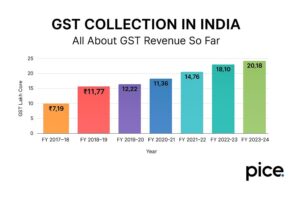Download Export Shipping Bill Format Under GST
- 9 Aug 24
- 14 mins

Download Export Shipping Bill Format Under GST
Key Takeaways
- A Shipping Bill is a mandatory legal document for the export of goods, required by customs authorities.
- Types of Shipping Bills include Dutiable, Duty-Free, Drawback, Ex-Bond, and Coastal, catering to different export scenarios.
- The Shipping Bill process involves preparation, electronic filing via ICEGATE, document verification, and the issuance of a Let Export Order (LEO).
- The revised format under GST incorporates GSTIN, tax invoice number, and GST rates, ensuring compliance with GST regulations.
- The generation of a shipping bill requires details like exporter and buyer information, invoice and packing list details, and GST-related information.
When it comes to trade in international markets, paperwork is the essential component that guarantees the shipment of goods from border to border. From these principal documents, the Shipping Bill stands out significantly, particularly in India, as it occupies the key driver role in the Goods and Services Tax (GST) system.
The purpose of this guide is to clear the haze around the export shipping bill format under GST, its creation process, reveal different types of this bill, and last but not least, evaluate the part concerning GST revision. Moreover, we will pay attention to the mechanism of submitting and editing an export bill that will help exporters navigate the world of international trade.
What is a shipping bill?
A shipping bill is a legal document required by the customs authorities for the export of goods. Under the GST regime, it's pivotal for the clearance of goods for shipment abroad. Important information about the goods being sold is listed, including their description, amount, worth, and where they are going. The seller's and buyer's information is also included.
This document is the basis for the customs authorities to calculate and levy any applicable export duties and to ensure compliance with export regulations.
Types of Shipping Bill
Exports are an important part of global trade because they make it possible for things to be traded across countries. An essential document in this process is the transport bill, which is required for the export of goods from one country to another.
The exporter must sign this paper, which is required by customs rules. It's an important part of getting through customs.
We need to look at the different types of shipping bills for this hard but necessary process.
- Dutiable Shipping Bill
A Dutiable Shipping Bill is used for goods that are subject to export duties or taxes. This type of transport bill is typically colored yellow and is required when the goods being exported are not exempt from customs duty.
The use of a Dutiable Bill ensures that all necessary taxes and duties on the exported goods are calculated and paid before shipment, facilitating a smooth customs clearance process.
- Duty-Free Shipping Bill
As the name suggests, a Duty-Free Shipping Bill is used for goods that are exempt from export duty. These goods do not attract any taxes at the time of export.
The Duty-Free Bill is colored green and is necessary for exporters who are transporting goods that are either not taxable under the customs laws or are eligible for duty exemption. This facilitates a faster clearance process since no duty calculation is required.
- Drawback Shipping Bill
A Drawback Shipping Bill, colored blue, is utilized for goods that are eligible for a refund of customs duties previously paid on imported materials or components used in the manufacture of the exported goods.
Exporters can get a drawback, or a refund of customs taxes, on the materials that were brought in to make the things that are being shipped. To support the claim for a drawback, detailed information about the purchased goods and the export deal must be sent.
- Ex-Bond Shipping Bill
An Ex-Bond Shipping Bill is used for goods that were previously imported and stored in a bonded warehouse and are now being re-exported.
This type of bill is colored yellow and is required for the re-export of bonded goods without payment of import duty. It facilitates the clearance of goods that were not initially imported for domestic consumption but were stored for re-export.
- Coastal Shipping Bill
A Coastal Shipping Bill is used for the shipment of goods from one port to another within the same country via sea. This bill is white and is needed for moving goods along the coast of the United States, not for sending goods to other countries.
Although it is not an export document per se, it is crucial for the proper documentation and tracking of goods moving within national boundaries by sea.
How does the Shipping Bill process work?
The first step is for the exporter to make the shipping bill, which lists the things that are going to be exported. Once submitted to the customs authorities, it undergoes scrutiny to ensure all information is accurate and complies with the export regulations.
Upon approval, the goods are allowed to be loaded onto the shipping vessel, and the Bill is stamped, serving as proof that the goods have left the country.
Procedure for Generating a Shipping Bill
The generation of a shipping bill is a digital process facilitated through the Indian Customs Electronic Commerce/Electronic Data Interchange (EC/EDI) Gateway, commonly referred to as the ICEGATE.
Exporters or their agents are required to file the bill electronically, along with the necessary documents such as the invoice, packing list, and any other relevant certifications.
How is the shipping bill generated?
Here's an overview of the shipping bill generation process under the Goods and Services Tax (GST) regime in tabular format:
Step Description
| Step | Description |
|---|---|
| 1. Preparation of Shipping Documents | Before generating a bill, necessary documents such as the commercial invoice, packing list, export order, and any relevant certificates or declarations are prepared based on the nature of the goods. |
| 2. Filing of Shipping Bill | The shipping bill filing starts electronically via the ICEGATE portal under the GST regime. Exporters or their agents must register and file the bill along with all necessary documents electronically. |
| 3. Details Required for Shipping Bill | The shipping bill must include exporter's and buyer's details, invoice details, packing list details, Harmonized System (HS) code, description, quantity and value of goods, destination port, transport details, and GST details, including GSTIN and tax invoices. |
| 4. Document Verification | Customs officials review the documents for accuracy and may physically examine the goods. Compliance with regulatory requirements, such as quality control and export promotion schemes, is also verified. |
| 5. Let Export Order (LEO) | Upon satisfactory document and goods verification, a "Let Export Order" (LEO) is issued, signifying customs clearance of the goods for export. This allows the goods to be loaded onto the shipping vessel or aircraft. |
| 6. Generation of Shipping Bill | After issuing LEO, the bill is generated and assigned a unique identification number, acting as a receipt for the goods submitted to customs for further processing and documentation. |
| 7. Other Considerations | If amendments are required after the bill has been generated, exporters must approach customs officials with valid reasons for changes related to invoice details, buyer details, HS codes, or other aspects of the export transaction. |
With the implementation of GST, the format of the Bill has been revised to incorporate GST-related details such as the GSTIN of the exporter, the tax invoice number, and the rate and amount of GST paid. This ensures a seamless flow of credit and compliance with GST regulations.
Export Shipping Bill Format Under GST
The export shipping bill format under the Goods and Services Tax (GST) regime in India is a standardized document that is crucial for the export of goods. It contains detailed information about the shipment, facilitating customs clearance and compliance with international bill regulations.

The format of the bill has been designed to incorporate GST-related details, ensuring that all tax-related information is accurately captured and processed. Here's an overview of the key sections and information typically included in an export shipping bill format under GST:
Exporter and Consignee Details
- Exporter's Name and Address: Full name and address of the exporter.
- GSTIN: The Goods and Services Tax Identification Number of the exporter.
- IEC: Importer-Exporter Code issued by the Directorate General of Foreign Trade (DGFT).
- Consignee's Name and Address: Full name and address of the overseas buyer.
Shipment Details
- Shipping Bill Number and Date: Unique identifier for the bill and the date of issue.
- Port of Loading: The Indian port from which goods are to be exported.
- Destination Port: The foreign port where goods are to be delivered.
- Country of Destination: The country to which the goods are being exported.
Goods and Invoice Details
- Description of Goods: A detailed description of the goods being exported.
- HSN Code: Harmonized System Nomenclature code for each item.
- Quantity and Unit: Quantity of goods and the unit of measurement.
- Invoice Number and Date: Related to the sale transaction of the exported goods.
- Value of Goods: Total value of the goods being exported, in Indian Rupees or the agreed foreign currency.
- GST Details: Details of GST paid, if any, including IGST (Integrated GST).
Transport and Freight Details
- Mode of Transport: This specifies whether the goods are shipped by air, sea, or land.
- Name of the vessel, flight, or truck: Identification of the carrier transporting the goods.
- Freight and Insurance Details: Information on freight and insurance charges, if applicable.
Declaration and Certification
- Exporter's Declaration: A declaration by the exporter certifying the accuracy of the information provided in the bill and compliance with applicable export regulations and GST laws.
- Authorized Signatory: The name and signature of the person authorized to declare the bill details on behalf of the exporting company.
Customs Use
Customs Officer's Endorsements: Sections for use by customs officials for recording examination reports, valuation details, and the grant of "Let Export Order" (LEO).
How do I correct or amend a shipping bill?
Correcting or amending an export shipping bill format under GST is an important process in the export documentation under the Goods and Services Tax (GST) regime, particularly when errors are detected after the bill has already been generated and submitted.
The process ensures that accurate details are recorded, thus avoiding potential legal and logistical issues. Here is a step-by-step guide on how to correct or amend a shipping bill:

Step 1: Identify the Error
The first step is to thoroughly review the bill and identify any inaccuracies or errors that need correction. These errors could range from typographical mistakes to incorrect product descriptions, HS codes, or financial information.
Step 2: Check for Amendment Permissions
Not all details in a shipping bill can be freely amended after submission. It's crucial to check the customs regulations to understand which aspects of the bill can be amended post-submission and under what circumstances.
Generally, minor corrections are more straightforward to make than significant changes, which might require more extensive justification.
Step 3: Submit an Amendment Request
Once you've identified the error and confirmed that an amendment is permissible, the next step is to submit an amendment request. This process is typically done through the same electronic system used to file the original shipping bill, such as the ICEGATE portal in India.
The request must clearly describe the error and the proposed correction, accompanied by any relevant supporting documents.
Step 4: Provide Justification for the Amendment
For significant amendments, you may need to provide a detailed justification for the change. This might include documentation or evidence supporting the reason for the amendment, such as corrected invoices, letters from the buyer, or revised regulatory certifications.
Step 5: Approval by Customs Authorities
The customs authorities then review the amendment request. This review process may involve verifying the justification provided, checking the revised details against regulatory requirements, and ensuring that the amendment does not violate any export or customs policies.
The time taken for approval can vary depending on the complexity of the amendment and the workload of the customs office.
Step 6: Amendment Implementation
Once the amendment request is approved, the changes are implemented in the shipping bill. The customs authorities will issue a revised bill reflecting the corrected details. It is essential to review the amended bill to ensure that all corrections have been accurately made.
Step 7: Notification of Stakeholders
After receiving the amended shipping bill, notify all relevant stakeholders of the changes. This includes the transporting company, the importer or buyer, and any other parties involved in the logistics chain.
Ensuring that all parties have the most up-to-date information is crucial for avoiding complications during the transport and importation process.
Tips for Avoiding Amendments
- Double-check all information before submission. Careful review and verification of all details before submitting the bill can prevent many common errors.
- Understand customs requirements: Familiarity with the customs regulations and requirements for your specific export goods can help ensure accuracy in the initial submission.
- Use a reputable customs broker: If you're unsure about the process, consider employing the services of a professional customs broker who can ensure that your documentation is accurate and compliant with all regulations.
Conclusion
Moving goods from one country to another is now legal and easy, thanks to the bill. This is a key part of the export process. To make sure they are following the rules and taking advantage of benefits like tax drawbacks, sellers need to know the different types of it, how it is made, and how to change it.
Since GST and digitizing immigration processes came along, the process is easier to follow, but it still needs careful attention to detail and following the rules. To be successful in the foreign market, you will need to stay up-to-date on changes in paperwork and processes and be able to adapt to them.
💡Paperwork is slowing down your business. Download the PICE app today and experience seamless GST payment processing.
 By
By 















